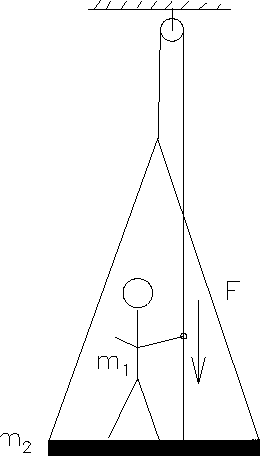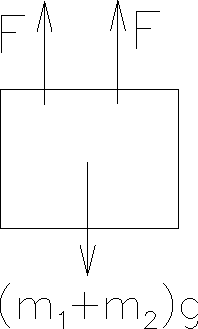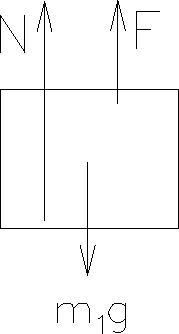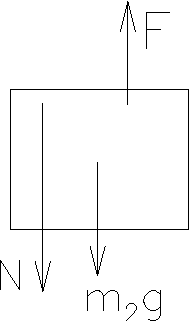Problem 3:
 A painter of mass m1 = 60 kg stands on a platform
of mass m2 = 15 kg, which is suspended by a
massless rope over a frictionless pulley as shown. She
raises herself by pulling down on the rope with force
F.
A painter of mass m1 = 60 kg stands on a platform
of mass m2 = 15 kg, which is suspended by a
massless rope over a frictionless pulley as shown. She
raises herself by pulling down on the rope with force
F.
a) What force F is needed to keep the painter and
platform moving with constant velocity?
b) Assume instead that F = 400 N (downward). What is
the acceleration of the person and the platform?
Solution:
Easier solution:
- Since the painter and the platform move together, we can
consider them together as one system of mass m1+m2.
There are only three forces acting on this system, all of them in
the vertical direction:
- i) The weight of the system = (m1+m2)g
downward
- ii) The reaction force that the rope exerts on the painter,
F. From the 3rd law, if the painter pulls down on the rope with F, the
rope pulls back up on the painter with F.
- iii) The force that the other end of the rope exerts on the
platform (where it is attached at the top). Since the rope is
massless, the tension in the rope is uniform throughout, so
this is also F upwards.

- Thus, applying F = Ma to the system, and setting
a=0 (since velocity is a constant), we have
- F + F - (m1+m2)g = 0
- or
- F = (1/2)(m1+m2)g
- = (1/2)(60 kg + 15 kg)(9.8 m/s2) =
368 N
- b) repeat, this time where a is non-zero, but now
F is fixed to be 400 N:
- F + F - (m1+m2)g = (m1+m2)a
- or
- a = [2F - (m1+m2)g]/(m1+m2)
= 0.867 m/s2 (upwards)
Slightly harder solution:
-
a) There are two masses involved, m1 and
m2, so we can draw force diagrams for each.

- For the painter (m1) we have the upward normal
force N that the platform exerts on her, her weight (m1g
downward), and the upward force the rope exerts on her (since she
pulls down on the rope, Newton's 3rd law says the rope pulls up with
an equal yet opposite force on her). All the forces are vertical, so
we have
- F + N - m1g = m1a = 0 (i)
- since a=0 for constant velocity.

- For the platform (m2) we have the downward normal
force N that the painter exerts (equal and opposite to N!), its weight
(m2g downward), and the upward force the rope exerts (after
it passes over the pulley) on the top of the platform. Since the rope
is massless, the tension in the rope is constant throughout, so this
is just F. Again, all the forces are vertical, and again, the
acceleration is required to be zero, so we have
- F - N - m2g = m2a = 0 (ii)
- So, we have two equations in two unknowns (T, and F), so the
problem is solved except for the algebra. Solving (i) for N we have
- N = m1g -F
- plugging this into (ii) we have
- F - (m1g - F) - m2g = 0
- or
- 2F = (m1+ m2)g
- F = (1/2)(m1+ m2)g = (1/2)(60 kg + 15 kg)(9.8 m/s2) = 368 N
- b) Everything is the same as above (same force diagrams),
except now the acceleration is
not zero, and the F is given. Thus we have, as above,
- F + N - m1g = m1a (i)
- and
- F - N - m2g = m2a (ii)
- Now we again have two equations in two unknowns (a and N), and so all we have
left is algebra. From (ii) we have:
- N = F - m2a - m2g
-
- plugging this into (i) we get
- F + (F - m2a - m2g) - m1g = m1a
- 2F - (m1a + m2)g = (m1g + m2)a
- or
- a = [2F- (m1a + m2)g]/(m1g + m2)
- plugging in the masses, F=400 N, and the value of g we get
- a = + 0.867 m/s2
- where the positive sign indicates that the acceleration is upwards.
Next problem
Test 1 page
Physics 101 Home page
Physics Department Home Page
College of William and Mary,
Dept. of Physics
 A painter of mass m1 = 60 kg stands on a platform
of mass m2 = 15 kg, which is suspended by a
massless rope over a frictionless pulley as shown. She
raises herself by pulling down on the rope with force
F.
A painter of mass m1 = 60 kg stands on a platform
of mass m2 = 15 kg, which is suspended by a
massless rope over a frictionless pulley as shown. She
raises herself by pulling down on the rope with force
F.  A painter of mass m1 = 60 kg stands on a platform
of mass m2 = 15 kg, which is suspended by a
massless rope over a frictionless pulley as shown. She
raises herself by pulling down on the rope with force
F.
A painter of mass m1 = 60 kg stands on a platform
of mass m2 = 15 kg, which is suspended by a
massless rope over a frictionless pulley as shown. She
raises herself by pulling down on the rope with force
F. 

